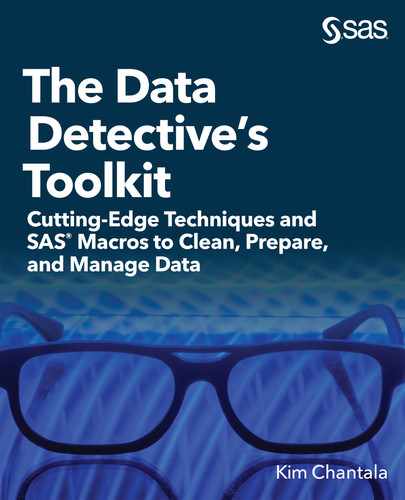Reduce the cost and time of cleaning, managing, and preparing research data while also improving data quality!
Have you ever wished there was an easy way to reduce your workload and improve the quality of your data? The Data Detective’s Toolkit: Cutting-Edge Techniques and SAS Macros to Clean, Prepare, and Manage Data will help you automate many of the labor-intensive tasks needed to turn raw data into high-quality, analysis-ready data. You will find the right tools and techniques in this book to reduce the amount of time needed to clean, edit, validate, and document your data. These tools include SAS macros as well as ingenious ways of using SAS procedures and functions.
The innovative logic built into the book’s macro programs enables you to monitor the quality of your data using information from the formats and labels created for the variables in your data set. The book explains how to harmonize data sets that need to be combined and automate data cleaning tasks to detect errors in data including out-of-range values, inconsistent flow through skip paths, missing data, no variation in values for a variable, and duplicates. By the end of this book, you will be able to automatically produce codebooks, crosswalks, and data catalogs.
Table of Contents
- About This Book
- About the Author
- Acknowledgments
- Chapter 1: Advantages of Using the Data Detective’s Toolkit
- Chapter 2: The Data Detective’s Toolkit and SAS
- Chapter 3: Codebooks: A Roadmap to Your Data
- Introduction
- Understanding Codebooks
- Using the %TK_codebook Macro
- Syntax
- A Word of Caution When Using Excel to Create Your Codebook
- Ordering Variables in Codebook
- Output Data Set
- Example 3-1: Create a Codebook with Potential Problem Reports
- Interpreting the Codebook
- Understanding the Potential Problem Reports
- Inside the Toolkit: %TK_codebook
- Summary
- Chapter 4: Customizing Codebooks
- Introduction
- Example 4-1: Embellishing Titles
- Example 4-2: Add a Logo to Your Codebook
- Example 4-3: Codebook Output Data Set and Default Design
- Understanding the Default Codebook Template
- Formatting Your Codebook with the Default Codebook Design
- Example 4-4: Create a Custom Design for Your Codebook
- Modifying the Default Codebook Template
- Updating the Design of Your Codebook
- Summary
- Chapter 5: Catalog Your Data
- Chapter 6: Detecting and Correcting Data Errors
- Introduction
- Harmonizing Data Sets: Using the %TK_harmony Macro
- Syntax
- Output Data Set
- Example 6-1: Harmonizing Two Data Sets
- Inside the Toolkit: How %TK_harmony Works
- Finding Duplicates: Using the %TK_find_dups Macro
- Syntax
- Example 6-2: Identifying Duplicates Based on Multiple Variables
- Inside the Toolkit: How %TK_find_dups Works
- Summary
- Chapter 7: Inspect and Edit Flow through Skip Patterns
- Introduction
- Understanding Skip Patterns
- Identifying Skip Patterns in a Survey
- Traditional Method of Auditing Skip Patterns
- Example 7-1: Using the %TK_skip_edit Macro
- Syntax
- Required Arguments
- Optional Arguments
- Tally Results Data Set
- Skip Formats
- How Skip Path Logic Is Implemented by %TK_skip_edit
- A Blueprint to Using %TK_skip_edit
- Example 7-2: Automated Method of Checking Skip Patterns
- Examining the Tally Report
- Examining the Edits Reported in the Crosstab Tables
- Inside the Toolkit: How %TK_skip_edit Works
- Summary
- Chapter 8: Create and Validate New Variables
- Introduction
- Coding Variables
- Coding Missing Values
- Using Formats to Recode Data Values
- Example 8-1: Using Formats to Recode Data Values
- Easy Ways to Check Variable Construction
- Example 8-2: Checking Indicator Variables Created from Ordinal Variables
- Example 8-3: Checking Categorical Variables Created from Continuous Variables
- Summary
- Appendix A: Your Part in the Data Life Cycle
- Appendix B: Skip Pattern Data Codebook
- Appendix C: Research Data Codebook
